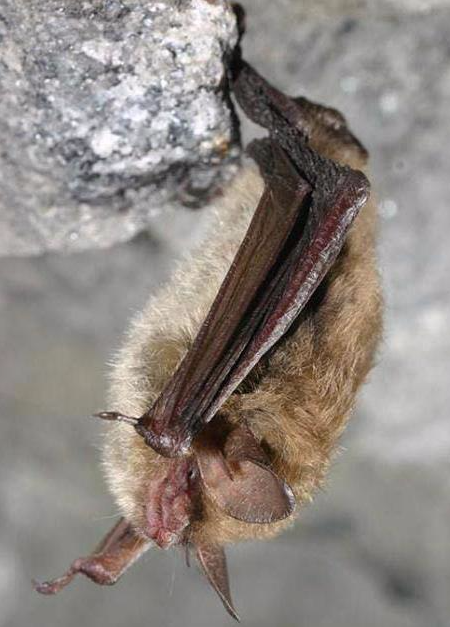Volume 25, Number 6 ● March 23, 2017
Bats: Time of Year Restrictions Around the Corner
It’s that time of year when bats are starting to emerge from their winter roosts, beginning their migrations and breeding seasons. If your project intends to clear trees in the spring and summer months, you need to make sure you have planned ahead. Time of year restrictions go into effect on tree clearing for certain projects near hibernacula (e.g., caves) and known maternity roost trees. Read on to make sure you’ve done your due diligence!
Different Strokes, for Different… Species (and States)
Hibernating northern long-eared bat. Photo courtesy of Al Hicks New York DEC
The northern long eared bat (Myotis septentrionalis) is a federally threatened species protected under the Endangered Species Act and is known to occur in both Maryland and Virginia; however, Virginia also has protections for a number of other tree-dwelling species of bats including the little brown bat (Myotis lucifugus) and the tri-colored bat (Perimyotis subflavus). The federally endangered Indiana bat (Myotis sodalis) is also known to occur in Virginia (though not Maryland) and has the strictest time of year restrictions of any of these species. We address each species in the remainder of this article.
Northern Long Eared Bat
The final 4(d) rule for the northern long eared bat allows incidental take (from activities such as tree clearing) throughout most of Virginia and Maryland as long as the activity meets certain parameters.
| Allowed | Not Allowed |
|---|---|
| Tree clearing activities greater than 0.25 miles from known hibernacula (e.g., caves) at any time of year. | Tree clearing activities within 0.25 miles of known hibernacula (e.g., caves). |
| Tree clearing activities greater than 150 feet from known occupied maternity roost trees at any time of year. | Tree clearing activities within 150 feet of known occupied maternity roost trees from June 1 to July 31. Allowed outside of these dates, with coordination from FWS. |
| Hazard tree removal at any time of year for the protection of human life and property. |
In Virginia, the approximate location of known hibernacula and known maternity roost trees can be found on the Virginia Department of Game and Inland Fisheries website.
In Maryland you will need to coordinate with the USFWS Chesapeake Field Office if your project is in Allegany, Garrett, or Washington County in order to determine if your project is within the vicinity of hibernacula or a known maternity roost.
Little Brown Bat and Tri-Colored Bat
Both of these bats are state-listed in Virginia as endangered. Similar to the northern long eared bat, incidental take is allowed in certain circumstances.
| Allowed | Not Allowed |
|---|---|
| Tree clearing activities greater than 0.25 miles from known hibernacula (e.g., caves) at any time of year. | Tree clearing activities within 0.25 miles of known hibernacula (e.g., caves). |
| Tree clearing activities greater than 150 feet from known occupied maternity roost trees at any time of year. | Tree clearing activities within 150 feet of known occupied maternity roost trees from June 1 to July 31. Allowed outside of these dates; no additional coordination required. |
| Hazard tree removal at any time of year for the protection of human life and property. |
The approximate location of known hibernacula and known maternity roost trees can be found on the Virginia Department of Game and Inland Fisheries website.
Indiana Bat
As a federally endangered species, the Indiana bat is afforded more protections than threatened species and thus has a longer time of year restriction on tree clearing. In Virginia, the time of year restriction runs from April 15 to September 15 for areas outside of the 5.5-mile hibernaculum buffer and April 1 to November 15 for activities within the hibernaculum buffer.
In Virginia, counties where the Indiana Bat are known to occur include: Alleghany, Augusta, Bath, Bland, Botetourt, Bristol, Buchanan, Buena Vista, Caroline, Carroll, Clarke, Covington, Craig, Dickenson, Floyd, Frederick, Galax, Giles, Grayson, Harrisonburg, Highland, Lee, Lexington, Montgomery, Norton, Page, Pulaski, Radford, Roanoke, Roanoke (city), Rockbridge, Rockingham, Russell, Scott, Shenandoah, Smyth, Staunton, Tazewell, Warren, Washington, Waynesboro, Winchester, Wise, Wythe.
If your project is in one of these localities, coordination with USFWS will be necessary prior to tree clearing activities.
Need Help? Just light the Bat-Signal!
If you wish to further discuss how this information may affect your project or to have WSSI’s trained and certified staff conduct a survey for any of these species, please contact Ben Rosner, Mark Headly, or Mike Klebasko.


